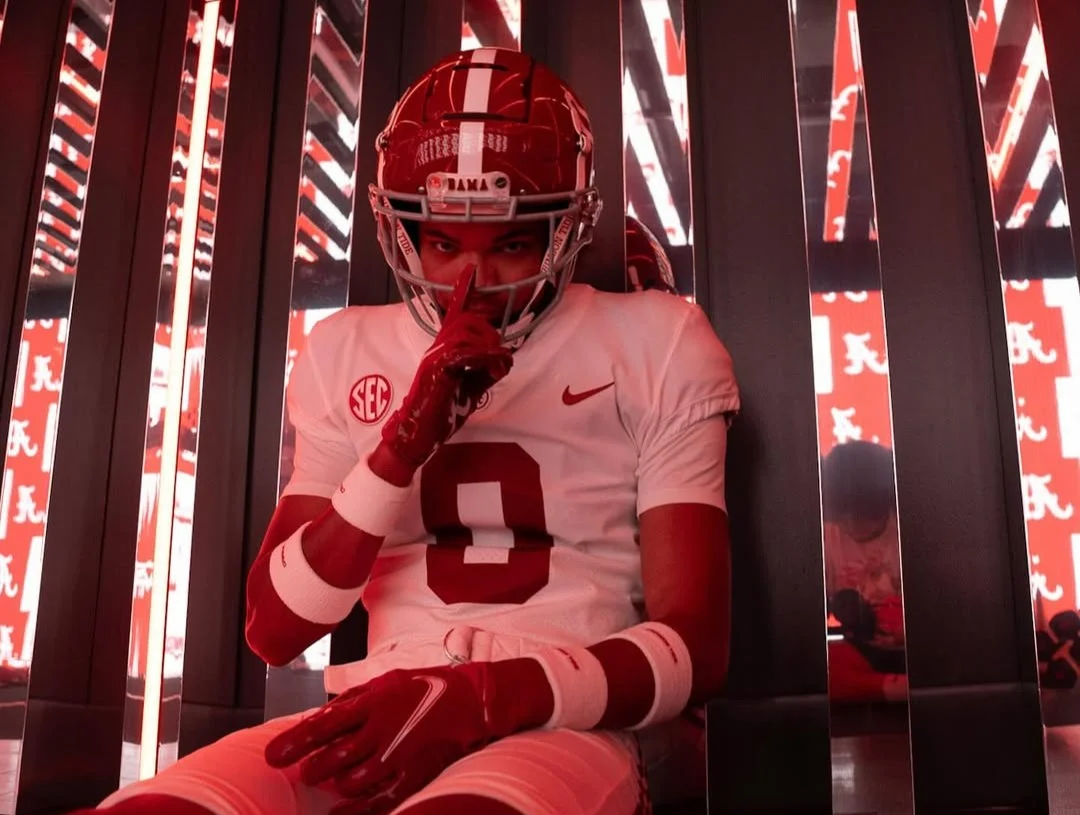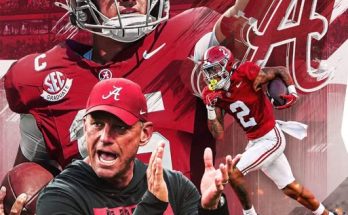The college football recruiting world reeled this week when Rihyael Kelley, a 6-foot-3 safety from Cincinnati’s Winton Woods High School, de-committed from Rutgers and pledged to Alabama following a whirlwind official visit to Tuscaloosa. It’s a move that underscores the strategic recruiting prowess of Alabama head coach Kalen DeBoer and his staff while delivering a stinging setback to the Scarlet Knights as they attempt to build sustained defensive momentum.
Kelley’s recruitment journey symbolizes the fluid and often unpredictable nature of modern college football recruiting. Initially, he committed to Toledo, only to switch to Rutgers on June 8. That commitment appeared solid—Rutgers had secured a coveted defensive back with ideal size and long-term upside. But in less than two weeks, Alabama stepped into the mix, hosted him, and ultimately forced a dramatic turnaround. On June 23, Kelley publicly flipped, leaving Rutgers and selecting the Crimson Tide instead (rutgers.rivals.com, profootballnetwork.com, on3.com).
From a purely talent-evaluation perspective, Kelley fits the prototype of a modern defensive back: towering at 6’3″, he offers versatility to play either corner or safety—a trait that Alabama coaching staff, including defensive backs coach Maurice Linguist, view as invaluable (bamahammer.com, on3.com). The Tide clearly sees long-term potential rather than an immediate starter—and that patience could be vital in molding Kelley into a pro-level defensive asset.
When reviewing Randolph’s flip timeline, the speed is staggering: Rutgers lands Kelley on June 8, he takes an official visit to Alabama just two weeks later, and by June 23 the commitment is reversed. That kind of turnaround speaks volumes about Alabama’s recruiting network, their ability to identify target prospects post-commitment, and—critically—their willingness to act fast and decisively with offers and visits (on3.com, bamahammer.com).
For Rutgers, losing a top-ranked safety commit is more than a blow—it’s a domino with potential to unsettle their defensive recruiting vision. Kelley was to be a foundational piece in constructing a more physical, disciplined secondary. His flip leaves a significant gap, not just in talent but in the psychological message to other recruits: if “Bama can swoop in, so can another contender,” they might think. And as Rutgers works to build legitimacy within the Big Ten hierarchy, these moments of vulnerability are costly.
By contrast, Alabama continues to roll. Kelley marks their roughly tenth commitment in the 2026 class and at least their third “flip” this week alone. Just hours prior, Alabama had flipped four-star running back Javari Barnett from Illinois and reinforced its secondary with additional defensive back pledges like cornerback Zyan Gibson. Quarterback Jett Thomalla also committed after visiting Tuscaloosa on June 17 (profootballnetwork.com, on3.com, bamahammer.com).
This surge in momentum is part of a broader trend under DeBoer’s leadership—targeting under-the-radar or lightly ranked players with upside, bringing them through OV pipelines, and converting late in the cycle. It’s a savvy strategy: instead of chasing only five-stars, Alabama looks for players with untapped potential; they leverage in-house evaluations and player development systems to transform late bloomers into college-level contributors (bamahammer.com).
From Kelley’s perspective, the decision makes sense on multiple levels. While Rutgers offered early opportunity and recruitment attention, Alabama delivers elite competition, coaching, facilities, and an NFL track record. Kelley himself celebrated the decision online: “Nothin’ but the Tide… thank you ma #LANK,” and later told On3’s Hayes Fawcett, “What excites me most about Bama is the chance to compete at the highest level. The coaches really believe in me, and with their resources and track record… they’re a program that can take me to the next level” (profootballnetwork.com, on3.com).
Digging deeper into his profile, On3 ranks Kelley as the No. 91 safety and No. 999 overall prospect, while the 247Sports Composite ranks him 84th among safeties and 40th in Ohio (profootballnetwork.com, on3.com). For Rutgers, that ranking would have represented a major get—Ohio isn’t their primary recruiting territory, and gaining a high-potential defensive back from the Midwest would have been a coup. Instead, the move now reads as a major recruiting coup for Alabama and a lost opportunity for Rutgers.
Kelley’s size and athleticism further amplify the disappointment. At 6’3″ and around 180 pounds, he provides the prototype frame coaches covet: length, field vision, and adaptability. Alabama’s coaching staff, including defensive analyst Kane Wommack and DB coach Maurice Linguist, clearly sees a player who can fill multiple roles in varying defensive schemes—making him a valuable chess piece in the secondary (bamahammer.com).
Strategically, Alabama’s recruitment of Kelley also illustrates the importance of player relationships. Reports show that defensive back Justin Hill and cornerback Cam Calhoun—both former teammates from Winton Woods—played instrumental roles. That insider connection, combined with the allure of being part of a championship culture, gave Alabama an edge in persuasion (rutgers.rivals.com, bamahammer.com).
Public reaction to the flip was swift and unfiltered. Bama-centric sites celebrated efficiently flipping a Big Ten commit, while Rutgers fans voiced frustration. The commitment reversal is more than a point of recruiting trivia—it’s emblematic of the current arms race in college football recruiting, where coaching staffs travel far beyond traditional regions, deploy targeted offers late in the cycle, and convert via high-pressure official visits and NIL promise.
Kelley’s statement underscores that reality: “Nun but the Tidee… thank you ma #LANK.” His tone reflects excitement, energy, and relief at landing in a program he clearly sees as upwardly mobile. That mindset is likely to energize Alabama’s recruiting base, while serving as a cautionary tale for programs like Rutgers: no commitment is untouchable, and a strong OV with a powerhouse program can tip the scales overnight (profootballnetwork.com, bamahammer.com).
Looking ahead, the implications for both teams are stark. Rutgers must regroup quickly—its evaluation of local and national talent at safety will be under greater scrutiny, and recruiting staff will need to reinforce remaining commitments while finding new targets. For Alabama, the addition of Kelley deepens defensive versatility, offering developmental upside in a secondary poised to contend at the top of the SEC and nationally.
In recruiting parlance, this kind of conversion is often called a “moment.” Alabama has now secured multiple moments across a short span—Javari Barnett, Jett Thomalla, and Rihyael Kelley are just the latest to flip. That streak enhances DeBoer’s narrative as a recruiter capable of “crossing enemy lines” and winning battles for talent posted on other programs’ announcement boards.
Statistically, the flip represents Alabama’s third from the Big Ten in a single day—two out of its first five commitments came from players who originally pledged to Illini and Rutgers (bamahammer.com, profootballnetwork.com). DeBoer’s recruiting team has clearly signaled its intent to dominate not just regionally but nationally, and these sustained flips validate that approach.
Breaking it down, there are three key lessons from Kelley’s flip:
- Swift action wins: Alabama moved within two weeks—from extending the offer to flipping the commit—demonstrating a relentless follow-through and urgency.
- Relationships matter: Leveraging alumni or former teammates, Alabama built personal connections that likely nudged Kelley’s decision after his OV.
- Upside trumps rank: Kelley is a lower-tier composite prospect, but his size, positional versatility, and coachability fit Alabama’s model of developing future starters.
For Rutgers, the flip serves as both caution and opportunity. The loss may sting, but it can galvanize the staff to shore up remaining defensive back targets and spotlight their own developmental track record within the Big Ten. Coach Greg Schiano’s program must signal that Rutgers is a destination for players who want to compete—and commit long-term. While Alabama offers immediate national stage, Rutgers can build its own program identity and prove players can develop just as much within its system.
Fans and analysts alike point to this summer’s recruitment as a showcase of DeBoer’s aggressive rebuilding strategy. Alabama is quickly reshaping its roster with players like Kelley who have size, upside, and movement skill. With multiple five-stars already committed—such as cornerback Jorden Edmonds—Kelley and company provide the depth and positional versatility needed for the depth-challenged seasons ahead (bamahammer.com, on3.com).
Meanwhile, Kelley steps into a program that has turned mid-to-late cycle commitments into immediate contributors at the college and NFL levels. That speaks to Alabama’s ability to develop talent and prepare players holistically for high-pressure roles—a promise few programs on Rutgers’ level can match routinely.
In the broader college football landscape, this flip encapsulates the relentless nature of SEC recruiting. While Power Five programs vie for five-stars, Alabama also targets overlooked prospects. They understand that on any given day, there are talented prospects available outside the national spotlight who, once developed, can outperform their initial projections. Kelley is the kind of recruit they play to secure: raw potential ready for cultivation.
If you zoom out even further, recruiting flips like Kelley’s expose the fragile nature of verbal commitments in the modern era. With NIL deals, transfer portal buzz, and constant communication, prospects increasingly feel empowered to make last-minute decisions. Programs must treat live commitments with active recruiting strategies—they must reinforce them continuously. Rutgers’ loss of Kelley suggests that the Scarlet Knights may need to rethink retention strategies amid the scramble of unofficial and official visits.
Still, every flip offers a silver lining. The urgency created by losing Kelley forces Rutgers to double down on remaining targets. And it reminds coaches that they must stay engaged until National Signing Day. It might even open the door to recruits who respect a rebuilding team’s transparency and opportunity narrative.
Coming full circle: Rihyael Kelley’s flip is both a showcase and a cautionary tale. For Alabama, it’s another recruiting win that strengthens depth, adds versatility, and fuels momentum. Alabama’s staff has proven again that they prioritize the recruitment process’s endgame just as much as its start. For Rutgers, it’s a wake-up call—top recruits are never safe, and even fast-moving programs can be disrupted by strategic visits.
In short, the football recruiting game has changed dramatically. The lines between programs are blurrier than ever. And in that environment, coaches must recruit, develop, and reinforce with equal intensity. Kelley’s story is emblematic of that era: young players empowered to choose, driven by opportunity, and willing to pivot in pursuit of their highest goals.
As summer camps and festivals continue, expect more seismic flips like this one. The recruitment landscape is evolving and Kalen DeBoer—and coaches like him—are already writing the playbook for the next generation of recruiting battles.
This dramatic shift of a top commit highlights major trends in modern recruiting: the power of quick action, the weight of relationships, and the importance of developmental promise. For Rutgers it’s a moment of reckoning; for Alabama, another notch on a burgeoning recruiting blueprint that’s steadily reshaping a program aiming to reclaim its national edge.
Let me know if you’d like to adjust the tone, add multimedia, or extend the analysis further!



